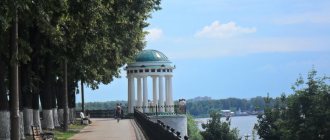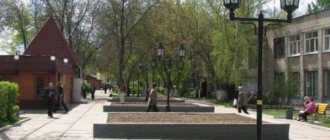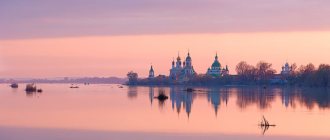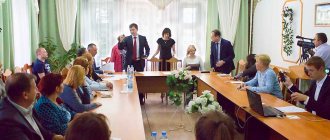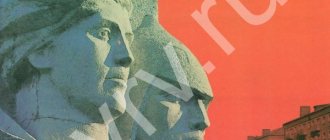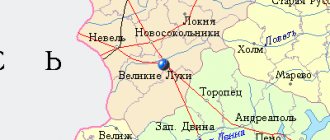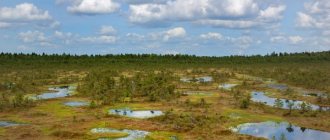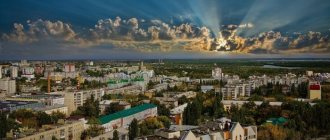Kovrov is a unique city of its kind, in which Russian history and modernity are closely intertwined.
The city was founded in 1778. The first settlement on this site was erected thanks to Yuri Dolgoruky, it was named Elifanovka. Later, thanks to Andrei Bogolyubsky, this village was renamed Rozhdestvenskoye. In the sixteenth century, the family estate of the Kovrov princes was located in the village. It was from their surname that the modern name of the city was formed.
The city of Kovrov is famous for its defense industry and heavy engineering, motorcycles, textile production and Kovrov toys.
All sights of Kovrov (15)
The attractions of Kovrov are presented on this page in the form of a rating based on tourist reviews. So what is interesting to see in Kovrov? Below, all the attractions of Kovrov are collected in one summary table: each attraction is equipped with a large photo, a detailed description, address and telephone number, marked on the map, and any tourist can leave a review for it.
- popularity
- popularity
- name
- name
- All attractions (15)
- Architecture: buildings and structures (2)
- Temples and monasteries (4)
- Museums, exhibitions and galleries (6)
- Observation platforms (0)
- Monuments and Monuments (1)
- Historical districts, streets, squares (1)
- Natural sites, gardens and parks (1)
- Amusement parks, water parks (0)
- Zoos, aquariums (0)
- Theatres, cinemas, circuses and stadiums (0)
- Festivals and holidays (0)
- Markets, shopping, shops (0)
- Memorials and cemeteries (0)
- Technological attractions (0)
- Educational and scientific institutions (0)
- Tourist Information Centers (0)
Factory "Kovrov Clay Toy"
Kovrov Historical and Memorial Museum
Spaso-Preobrazhensky Cathedral of Kovrov
Museum and leisure center in Marinino
Kovrov fire tower
Shopping arcades of Kovrov
Klyazma town
House-Museum of Degtyarev
Church of John the Warrior
Hare Museum
There are few attractions in Kovrov; it is not included in the Golden Ring excursion tour, but there are several historical and architectural monuments that are worth visiting this city for.
For example, V. A. Dyagterev, a famous weapons engineer, lived and worked here until his death. Thanks to his hard work and intelligence, during the Great Patriotic War, more than millions of different types of weapons for the front came out of the assembly line of the Tool Plant in Kovrov, an armored train was produced, and several revolutionary discoveries were made in the military industry. Now the house where the figure lived has been turned into a memorial museum, it tells about the scientific works of the explorer, and the environment in which Dyagterev worked has been restored. Also on the territory of the park named after A.S. Pushkin there is a gunsmith’s grave, and a monument is erected almost in the center of the city.
Of course, it’s worth visiting the clay toy museum. Such an excursion will be especially interesting for children, because there are so many colorful and vibrant characters in this exhibition: villagers, boyars, characters from fairy tales, even prominent scientists - all are depicted in the comic manner of clay toys.
All children, without exception, and adults too, will be delighted with the modern museum dedicated to hares. Here you can not only learn a lot of new things about long-eared animals, but also play with each exhibit at the exhibition.
Arriving in Kovrov, take the time to explore the city’s few, but unique in its color, churches. The Nativity Church amazes with its non-standard masonry and appearance, the Transfiguration Cathedral and the Church of St. John the Warrior - with their history. The churches of Kovrov have recently been restored and are in very good condition.
Sights of Kovrov
Architectural sights of Kovrov
Like any ancient city, Kovrov is interesting for its historical buildings. Among them is a former shopping mall building dating back to the end of the nineteenth century, which has been beautifully restored and today hosts an institution called a “business incubator”.
And nearby stands an amazing eighteenth-century church, this is the Church of the Nativity of Christ, which replaced the one built by order of Andrei Bogolyubsky. This church has won the unfailing love of the townspeople not only for its beauty. From 1946 to 1991 it was the only Kovrov temple: all the others were closed or destroyed.
Address: Volodarskogo street, 1
History of the city of Kovrov
But let’s return to an earlier story, because the village was not called Elifanovka for very long. In 1157, Prince Andrei Bogolyubsky got lost on the way from Suzdal to Starodub (there will be a separate post about this amazing city, which is not on the map, a little later). In the dark, he came across a village and, in honor of his “miraculous” salvation, ordered the construction of a Nativity Church in the village (after all, all this happened just before the Nativity of Christ), and the village eventually became known as Rozhdestvenskoye.
In the 16th century, the village was transferred to the Starodub family - the Kovrov princes, and in Russian history it’s always like this - the owner changed and let’s rename everything. The name of the village also changed - it became known as Kovrovo.
The history of Kovrov as a county town began under Empress Catherine II. By her order, in September 1778, a new Kovrov district was established, and the village of Kovrovo began to be called a city.
Kovrov: what to see and where to go in the city and its surroundings
Kovrov is a small town in the Vladimir region, located on the coast of the Klyazma River.
The first settlement, which became the predecessor of modern Kovrov, was founded by decree of Prince Yuri Dolgoruky in the 12th century and was called Elifanovka.
Later, Prince Andrei Bogolyubsky renamed the place the village of Rozhdestvenskoye and built a railway there. In the 16th century, the estate came into the possession of the Kovrov family and received its name.
Thanks to the developed railway, Kovrov's economy began to grow rapidly. During the war, various weapons were produced here. In 2011, Kovrov was ranked among the cities of military glory.
How to get to Kovrov?
From Moscow you can get to the city by train in about four hours. Trains passing through Kovrov depart from Yaroslavsky, Kazansky and Kursky stations. You can also get to Kovrov through Vladimir, from where there are regular trains to Kovrov.
Buses to the city depart from the bus station in Moscow from the Shchelkovskaya metro station from nine in the morning until almost 11 in the evening, the travel time is about four and a half hours.
By car you can reach the city along the M7 highway.
Historical sites and museums
Kovrov Historical and Memorial Museum
The museum was founded on March 27, 1927. The names of the first directors have not reached our times. Employees of the institution have more than once taken part in archaeological research related to museum activities.
The halls house various historical exhibitions. Here you can see what the city was like in the 19th-20th centuries, examine its images on old postcards and printed publications. In addition, there are exhibits dedicated to animals and plants that lived on earth millions of years ago.
Museum of Nature and Ethnography
The museum was opened in November 2014. It was located in the building of the ancient estate of the former Kovrov merchants Bolshakovs. The building is famous for the fact that in the period 1918-1931 the family of V. G. Fedorov, who created the world’s first machine gun, lived in it.
The museum halls display a rich collection of wild birds and animals found in the Vladimir region. Here you can get to know the nature and wildlife of this region better.
In addition, here you can attend various master classes and interactive activities for children.
Fedorovsky Estate
The museum got its name from the former owner of the building. Once upon a time, the Fedorovskys were among the first rich people of Kovrov, and the house was one of the best in the city. Their family was famous for its huge library, part of which was included in the collections of various museums.
The library consisted of about several thousand volumes of both Russian and foreign classical publications. In 1918, hundreds of books were sold out, and some of them disappeared forever.
Currently, the Fedorovsky estate houses the halls of the city library of the Kovrov district.
Museum of Degtyarev V.A.
The museum is located on one of the central streets of the city, named after V. A. Degtyarev, a famous gunsmith.
The architects restored several rooms: a living room, a dining room, an office and a workshop. All things are located in the same places as during the life of the owner. These are photographs of loved ones, old books and magazines.
The basement once housed the craftsman's work area. Now there is a foot-operated lathe for working with wood. A small garden has been preserved on the territory of the house, in which V. A. Degtyarev spent his free time.
Shopping arcades of the 19th century.
The massive shopping arcade building was built in the period 1892-1893. For buildings of this type and purpose, it was very large. This is due to the fact that at the end of the 19th century the city experienced an unprecedented rise in population, which increased by 2 thousand people.
The building housed a local printing house for a long time. After reconstruction in 2011, it became a so-called “incubator” for local entrepreneurs. That is why the premises were equipped with special furniture and necessary equipment.
Hare Museum
The museum's halls display more than 1,000 exhibits: plush, wooden, glass, porcelain and a variety of hares. There are about 200 different copies of books dedicated to long-eared animals alone.
A special room was allocated for the exhibition, but “the hares stubbornly scattered throughout the museum” - among the racks, cabinets and shelves. You can play with almost everyone, so children definitely won’t get bored.
Churches and Temples
Transfiguration Cathedral
The cathedral was built in 1884 with money from local residents. Built from red brick, it became one of the most remarkable churches of Kovrov.
During Soviet times, it was looted and some parts of it were destroyed. Between 1934 and 1990, the building was used by the Bolsheviks as a prison for political prisoners.
In 1991, the building again came into the possession of the Diocese. Work was carried out to reconstruct it, and soon the doors of the cathedral opened to parishioners.
Ensemble of the Nativity Cathedral
It was built in 1778 on the site of a former dilapidated church, erected by order of Prince Andrei Bogolyubsky.
Among the residents of Kovrov there is a legend about how the prince lost his way in the forest. He walked among the trees for a long time until he saw a light sparkling somewhere in the distance. It was light coming from a small wooden hut. It was the house of a local forester.
Returning to the city the next morning, the prince ordered the construction of a church nearby as a reminder of recent events.
During Soviet times, the church was the only one operating in the city. Now the Nativity Cathedral is a complex of buildings consisting of the temple itself, a refectory and a bell tower.
Church of John the Warrior
The church was built in the first half of the 19th century and named in honor of the Great Martyr John the Warrior. He is the patron saint of offended or grieving people.
To this day, the tombstones of an ancient cemetery have survived on the territory of the temple. Shrines are kept here - icons of St. Athanasius and Bishop of Kovrov with part of the relics.
During Soviet times, the church was closed, and for the next 48 years it was empty. In 1994, the temple resumed its work.
Church of the Feodorovskaya Icon of the Mother of God, 1875
The red brick building is located opposite the station. And this is no coincidence.
The temple, erected in honor of the Feodorovskaya Icon of the Mother of God, is directly connected to the Moscow-Nizhny Novgorod railway.
Workers of the railway workshops submitted a petition to build a temple at their own expense “in memory of the event of April 4.” It was on this day that there was an attempt to assassinate Emperor Alexander II. Everything miraculously worked out, and a temple was erected in honor of saving the king from death.
What to see in Kovrov on your own?
Beautiful places and main attractions of the city and its surroundings: photos with descriptions, tips on where to go, where to go by car, what to see in one day.
Transfiguration Cathedral
Architectural monument. In 1884, city residents raised their own funds for the construction of the Cathedral. This has become one of the most beautiful churches in Kovrov. Built of red brick, with a high bell tower.
During Soviet rule, it was looted and partially destroyed. The Bolsheviks used the building as a prison for enemies of the people, and then they placed a warehouse in it. This story lasted from 1934 to the 90s of the 20th century.
In 1991, the Diocese returned the cathedral to its possession. Work was carried out to reconstruct it, and a new bell tower was erected. Services have resumed. There is a Sunday school at the cathedral. The bell tower of the Transfiguration Cathedral, which is located on a picturesque hill directly above the Klyazma River, has also been preserved.
The bell tower is clearly visible from a distance of several kilometers and is a landmark for tourists. Work to restore the complex has not been completed and is still underway.
- Address: Kovrov, st. Pershutova, 28.
Ensemble of the Nativity Cathedral
Architectural monument. It was erected in 1778 on the site of a church built by order of Prince Andrei Bogolyubsky.
There is a legend about how the prince got lost in the forest. But he saw a light flash among the thicket. It was light emanating from a small forest hut. The prince reached the house of a local hunter, spent the night there, and the next morning he ordered a wooden church to be built on this place as a reminder of the events that had happened to him.
The action took place before the Nativity of Christ, from which the holy place received its name. Subsequently, the wooden building was demolished and a white stone temple was erected in its place. During Soviet times, it was the only functioning church in the city. The rest were looted and closed. Today, the Nativity Cathedral is a classic stone building consisting of three parts: the temple, the refectory and the bell tower.
- Address: Kovrov, st. Pershutova, 15.
Church of John the Warrior
Orthodox church. Named in honor of the Holy Martyr John the Warrior. He is the patron saint of everyone who was once offended or grieves for someone. Initially, the church had the status of a cemetery. The ancestors of the Kovrov residents were buried here.
You can still see the tombstones of the old city cemetery near the temple. The church has its own shrines - these are icons of St. Athanasius and Bishop of Kovrov with the remains of relics. The temple has a half-century history, with which every resident of Kovrov is familiar.
During Soviet times, the church was closed and it stood empty for 48 years. During this time, the new government disfigured the appearance of knowledge: the bell tower was demolished, the bells were removed, and the windows were blocked with bricks. In 1994, the Temple in the name of the holy martyr John the Warrior found new life. Now, admiring the revived shrine, it is difficult to imagine that once the city almost lost it.
- Address: Kovrov, st. Pershutova, 7.
Church of the Life-Giving Trinity
Orthodox church. It is part of the Znamensky Convent. The start of construction dates back to 1913. At that time, the Holy Sign monastic community conceived a very large temple, which was erected until 1918.
The community was liquidated in 1920, and the church building was transferred to the machine gun factory (later JSC V.A. Degtyarev Plant). The monastic community was revived again in 2006. The temple was handed over to the nuns, repaired and reconstructed.
Find a suitable hotel or hostel
The massive building was originally built in the Russian style, therefore it is decorated with carved cornices, the window openings are framed by arches in the form of kokoshniks. The temple is crowned with a dome - an onion. Services are held here today. There is a Sunday school and a monastery library.
At one time, a healing spring came out of the ground here. This place is considered holy, since it was here that the miraculous icon of the Mother of God appeared to the nuns. In 2008, a Worship Cross was installed at this place. Since 2012, pilgrims can calmly pray to the Great Martyr and Healer Panteleimon in a specially created prayer house.
- Address: Kovrov, st. Pervomaiskaya, 28A
Kovrov Historical and Memorial Museum (former city government building)
Architectural monument. Initially it was created in the premises of the Elias Chapel. Then the main exhibitions were transferred to the former Zemstvo Administration, where they are still located. This beautiful city building was built at the end of the 19th century according to the design of the Moscow architect G.N. Ribasa.
The official opening date of the museum is March 27, 1927. During this time, a number of unique exhibitions were collected and presented to visitors. Here you can get acquainted with archaeological finds, the life of Kovrov residents at the turn of the 19th – 20th centuries, and plunge into the history of the Great Victory.
Since 2002, the museum has had a permanent exhibition introducing the public to the fauna of the region. In 2021, Kovrov turns 240 years old. Museum staff have prepared a number of events and new exhibitions for this date.
- Address: Kovrov, st. Abelmana, 20
- Admission: schoolchildren – 30 rubles, students and pensioners – 40 rubles, adults – 50 rubles.
Museum of Nature and Ethnography
Branch of the Kovrov Historical and Memorial Museum. Created in 2004. Located in the house of the famous designer - gunsmith V.G. Fedorov. The museum presents exhibitions “Kovrov clay craft: history and modernity”, “Nature of the Vladimir region and its protection”, “Fauna of the Vladimir region”. There is a thematic excursion with a master class on modeling and painting “The World of Clay Toys”
- Admission: schoolchildren – 30 rubles, students and pensioners – 40 rubles, adults – 50 rubles.
- Address: Kovrov, st. Fedorova, 6
Fedorovsky Estate
Architectural monument of regional significance. Built at the end of the 19th century. The red-brick house is named after its former owners - merchants Fedorovsky. The family took an active part in the construction of unique objects of Kovrov and gained fame as local philanthropists. They were known for their unique library, part of which was included in the collections of the Kovrov Museum of History and Local Lore.
At one time, the library contained several thousand volumes of literary works of domestic and foreign classics. But in 1918, when the estate was nationalized, part of the library was distributed to various institutions, and most of the copies disappeared forever.
The old house is interesting for its architectural design and will bring aesthetic pleasure to connoisseurs of past architecture. Now the central regional library is located here.
- Address: Kovrov, st. Abelmana, 86.
Plant named after V.A. Degtyareva
Vasily Alekseevich Degtyarev is another page in the glorious history of the city of Kovrov. Thanks to his activities, the city became known for its guns and machine guns, and during the war it massively supplied the Soviet army with necessary weapons.
This historical figure is rightfully given special veneration in the city. The plant, construction of which began in 1916, is named after him. The company was named after the weapons designer in 1949.
Now it is a diversified production facility that produces products for various sectors of the economy. The plant's control building also has historical value. Its history began in 1916, when workers began construction of the first workshops.
- Address: Kovrov, st. Truda, 4
Monument to small arms designer V.A. Degtyarev.
In 1954, the famous Kovrov gunsmith V.A. A monument was erected to Degtyarev, which is located at the beginning of the central alley along Abelman Street. The work of sculptor M.G. Manizer.
The monument is located in an iconic place of the city and is clearly visible from afar. Degtyarev is a unique person. He had only 3 years of education, but thanks to his work and abilities, he became a Doctor of Technical Sciences, Major General of the Engineering and Artillery Service, and was twice elected as a deputy of the Supreme Soviet of the USSR. He became the second person after Stalin to be awarded the title of Hero of Socialist Labor. Winner of 4 Stalin Prizes. He was awarded the Order of Lenin three times. Knight of the Order of Suvorov I and II degrees. Awarded the Order of the Red Banner of Labor and the Order of the Red Star. He is the developer of several models of light machine guns. He died in 1949 after a long illness.
- Address: st. Abelmana, square.
Museum of Degtyarev V.A.
The house in which Vasily Alekseevich Degtyarev lived with his family has been converted into a museum. The museum presents an exposition of the life and work of designers - gunsmiths of the city of Kovrov, a memorial complex has been created, and stands with historical photographs have been decorated.
The gunsmith's personal belongings are kept in the house-museum. The exhibition is based on the memories of V.A.’s children. Degtyarev, therefore the furnishings, things and household items fully correspond to the period of their life in Kovrov. The museum's exhibitions tell visitors about the simple and discreet lifestyle of the famous creator of small arms and his great developments for the benefit of the Fatherland.
- Address: st. Degtyareva, 6A
- Admission: schoolchildren – 30 rubles, students and pensioners – 40 rubles, adults – 50 rubles.
Fire station
One of the oldest depots in the Vladimir region. It was built in 1904 and is an architectural monument of regional significance. The red brick building, perfectly preserved to this day, attracts tourists with its majesty and scale.
The architectural solution is typical for the construction of fire stations of the early 20th century. This is a two-story building with gates for the exit and entry of fire engines and a central tower with an observation deck at the top. The depot is still in operation. It houses one of the city's fire departments.
- Address: Kovrov, st. Degtyareva, 61
Church of the Feodorovskaya Icon of the Mother of God, 1875
Work on the construction of the church began in 1874. The temple was built of red brick in pseudo-Russian style. The massive building originally belonged to the Ministry of Railways and Communications of the Russian Empire.
The church was built with donations from parishioners. The craftsmen donated a penny from every ruble they earned for the construction. City patrons also did not stand aside. Bells, crosses, icon vestments and other things necessary for the temple were purchased and installed with public money. When in the 20s of the 20th century, representatives of the new government began to remove utensils from the church, the residents of Kovrov came to their defense.
The temple was one of the first to be closed in the city, in 1924. Restoration work began in the early 90s. Since 2000, services began in the renovated church. Parishioners and guests of the city worship the throne image of the Feodorovskaya Mother of God, the Mozdok (Iveron) icon of the Blessed Virgin Mary.
- Address: Kovrov, st. Lopatina (according to the registration card, Bortsov str., 2)
Office of the Treumov factory, 1905
Built in 1905, a cultural heritage site. Factory I.A. Treumova was the largest enterprise in the city at the end of the 19th – beginning of the 20th century. Thousands of workers were employed in production.
At that time, it was a very modern building: a four-story building with bright rooms, asphalt floors, and concrete vaults. During the years of Soviet power, the enterprise was renamed the factory named after. Abelman.
During the Great Patriotic War, it supplied the army with clothing and military uniforms. Today the factory is not working. The building will be of interest not only to connoisseurs of industrial structures of the last century, but also to those who care about the history of our country.
- Address: Kovrov, st. Embankment, 13
Historical and Memorial Park
In 2021, the famous vacation spot for Kovrov residents is Park named after. A.S. Pushkin was reconstructed. In its place, the historical and memorial park “John the Military Necropolis” is now open and operating. The choice of location was not accidental.
Starting from the 15th century, there was a cemetery where the ancestors of the city, the Kovrov princes, were buried, and in the 18th century and during the First World War, the graves of citizens who contributed to the development of the city, soldiers who died in battles and died from wounds in the local hospital appeared.
In 1935, the cemetery was destroyed and the area was transformed into a city recreation park. Today it is again a place of historical memory. A memorial dedicated to the victims of Stalin’s repressions has been opened in the park, monuments and obelisks, and the graves of gunsmith V.A. Degtyarev and revolutionary A.Ya. Maleev have been preserved. and other prominent representatives of the city, gravestones were restored.
Thematic excursions and historical quests are organized and conducted in the park; the park is included in excursion tourist routes.
- Address: Abelman str., 20
"Width Mountain"
A picturesque hill located on the outskirts of the city. It was named after the robber Shirin, whose gang operated in this place, robbing local residents and passing merchants. They say that the gang leader buried treasure somewhere on a hill, but the location of the treasure has been revealed, so everyone who finds it will be in big trouble.
In 1905-1906, local Bolsheviks organized rallies, meetings and May Days here. In the 50s of the 20th century, Shirina Gora became famous for hosting winter motorcycle races. Representatives from all over the Soviet Union came to the competition, and for local residents the race remained in their memory as an unforgettable spectacle.
At that time, the plant named after. V.A. Degtyarev introduced a new production - he began to produce motorcycles. The winners were awarded these products of the enterprise. Today, Shirina Gora is a recreational place for citizens and guests of the city who want to spend time in the fresh air.
- Address: Kovrov, st. Belinsky, 25
Mass grave of Soviet army soldiers who died from wounds (1941-1945)
Kovrov was not occupied by the Nazi invaders, but, nevertheless, the city was awarded the title “City of Military Glory.” Being in the front-line zone, the city held events to help the front, a front-line hospital operated, volunteer detachments were formed and units of the partisan movement were organized.
In addition, at the plant named after. V.A. Degtyarev, under the leadership of the designer himself, weapons were produced for the army, including an anti-tank gun, created in the very first years of the war and so necessary for the fight against the invaders.
In memory of those events and people who gave their lives in the name of Victory, the monument was opened in 1968 and the Eternal Flame was lit. During the ceremony, at the site of the obelisk, a sarcophagus with earth taken from the mass grave was reburied.
- Address: pl. Pobeda, intersection of Shmidt and Soyuznaya streets.
Burial mound "Tinsky Perevoz"
Archaeological monument. Located near the village of Glebovo on the right bank of the river. Klyazma, Tinsky Perevoz tract. There are 105 mounds. The core of the burial ground is 20 cone-shaped mounds located in its central part with a height of 1.5-2.0 m and a diameter of 14-16 m. The remaining mounds have a height of 0.3-1.2 m and a diameter of 4-8 m.
All embankments are overgrown with trees and bushes, some are damaged by holes. Based on external features, the burial ground can be attributed to the ancient Russians of the pre-Mongol period. The carriage received its name from the village of Tina, which was liquidated, apparently as a result of riots during the Great Troubles in the 1620s. Once upon a time, the Shuya Highway, the site of a busy trade route, passed here. It existed since the Middle Ages and was in working order until the 60s of the 20th century.
Until now, travelers find the remains of road cobblestones in the forest. Goods and people were transported to the other side of the Klyazma River by ferry. This crossing was called the Tinsky crossing.
- Address: Kovrov, eastern part of the city, Tinsky Perevoz tract.
Museum of the estate of two generals
Structural subdivision of the Kovrov District Museum of History and Local Lore. Opened since 2021 in the village of Pavlovskoye in an old landowner’s estate, where at one time lived a friend of M.I. Kutuzov, a participant in the capture of the Izmail fortress under the command of A.V. Suvorov, General Andrei Yakovlevich Levanidov and a participant in the Patriotic War of 1812, the hero of the Battle of Borodino, General Vasily Semenovich Yukichev.
The authors and organizers of the new museum decided to hold a retrospective of the heroic events of the early 19th century. One of the most visited exhibitions is “Fear, O Army of Foreigners! The sons of Russia have moved…” - is dedicated to the life and activities of military leaders, one way or another connected with the Kovrov region.
Other exhibitions tell about the life of a provincial estate and the way of life of that time. In the manor park there is an obelisk to the heroes of the capture of Izmail.
- Address: Vladimir region, Kovrovsky district, Pavlovskoye village, st. Shkolnaya, 2
- Opening hours: Tuesday – Friday from 9.00 to 17.00, Saturday, Sunday from 9.00 to 15.00. Day off is Monday. Sanitary – last Friday of every month.
Taneyev Estate Museum
Located in the village of Marinino, which for three centuries, starting from the 17th century, belonged to the famous Russian family of Taneyevs. The museum complex includes a partially preserved estate: a house, a manor park and a church.
The house is an example of provincial noble architecture. Restoration and reconstruction began in 205. Since 2008, the museum has been fully operational. The public is presented with exhibitions on the history of the village of Marinino, the Taneyev family, and the famous Vladimir estates.
The museum actively cooperates with cultural organizations of the city and region, which allows the implementation of bright creative projects. The estate hosts thematic and chamber concerts. Thus, the Taneyevs’ museum-estate can be considered, on the one hand, as a historical object, and on the other hand, as a center of cultural life in the Vladimir region.
- Address: Vladimir region, Kovrovsky district, Marinino village, 49
- Opening hours: Tuesday – Sunday from 11.00 to 18.00. day off – Monday. Sanitary – the last day of the month.
- Admission: adults – 40 rubles, students – 30 rubles, children – 20 rubles.
Shopping arcades of the 19th century.
Monument of civil architecture of the late 19th century. The two-story brick building, reminiscent of a medieval castle, was built in 1892-1893. Architect unknown. It was intended for conducting trade affairs of local entrepreneurs. Z
The building is quite large and spacious, made of red brick. The style is somewhat reminiscent of the Moscow upper shopping arcades, but much smaller in area and more modest in design.
During the years of Soviet power, the Kovrov printing house operated here. In 2011, the rows were reconstructed, conference rooms and a press center were equipped. Currently it houses a local business incubator.
- Address: Kovrov, st. Pershutova, 16A
Hare Museum
Opened in 1999 on the basis of a family library. It is famous for its unique collection of hares, which includes soft toys, postcards, badges, and crafts. There are about 1000 exhibits in total. Hares don't just stand on shelves and racks. They are intended for playing and showing puppet shows that museum staff come up with for their visitors.
The exhibition is constantly updated thanks to gifts from the museum’s friends, colleagues, children, and businesses. When at the plant named after. V.A. Degtyarev began producing motorcycles, one of them, of course, with the symbols of a hare, became a museum exhibit. The smallest hare in the museum’s collection measures no more than 15 millimeters in size, and the largest is as tall as a child. The museum also carries out library activities. The fund is about 175 copies.
Avenue of Heroes
The alley was opened in 2000 in memory of the Kovrov residents - Heroes of the Soviet Union. 14 obelisks, installed in 2 rows of 7 on each side, tell about the exploits of people who, with their courage and courage, defended the freedom of the Motherland and glorified their hometown.
Commemorative events are held on the Alley of Heroes. Schoolchildren are brought here for thematic lessons and Lessons of Courage. It is no coincidence that the alley is one of the city’s attractions and is one of the monuments to those killed during the Great Patriotic War.
More than 19 thousand Kovrov residents went to the front during the entire military campaign, over 8 thousand did not return from the battlefields, 14 of them were awarded the title of Hero of the Soviet Union.
- Address: Kovrov, Victory Square.
Mass grave of partisans
The memorial plaque is installed in the very center of the city. Here lie the remains of three young partisans from Kovrov - Alexey Akimov, Yuri and Flaviy Sorokin. They went to the front in 1941. When assigned, they ended up in a special unit of the NKVD, where they trained intelligence officers and radio operators to work in the German rear. All three died while carrying out a mission in 1942 in the Smolensk region. The remains were transported to Kovrov and reburied in 1989.
The monument is cared for not only by workers of the plant named after. V.A. Degtyarev, but also representatives of other city enterprises. Kovrov residents pay tribute to the memory of the dead with respect and gratitude.
- Address: Kovrov, st. Socialist
Monument to military builders
Opened in 2021. The idea belongs to war and labor veterans of the city of Kovrov. The obelisk immortalized the memory of the people who forged Victory during the war years, working on the construction of military and defense facilities.
The opening of the monument was timed to coincide with the 40th anniversary of the arrival of the first platoon of military builders in Kovrov. It was these people who for many years strengthened the military-industrial potential of the city, and after the war improved people’s lives by erecting new residential buildings.
Boiler houses built by military builders still serve the population, heating almost half of the city. “Where a builder comes for a year, life comes forever!” - reads the inscription on the obelisk.
- Address: Kovrov, st. Griboyedova
Klyazma town
The village in the Kovrovsky district is famous for its centuries-old history. Starodub-on-Klyazma, the town on the site of which the village is located, was founded by Prince Yuri Dolgoruky back in 1152. At one time it was the center of a separate principality. During the Great Troubles, it was completely destroyed by the troops of False Dmitry II. All that remains of the settlement are the ramparts.
In 1659, the land went to Prince Vladimir Volkonsky, who nicknamed it the Klyazma town. Gradually the village began to be rebuilt. A stone Church of the Intercession of the Virgin Mary with a 40-meter bell tower appeared. The church is still active today. In 2003, a stele was erected in the village in memory of the 850th anniversary of Starodub-on-Klyazma.
- Address: Vladimir region, Kovrovsky district, village of Klyazminsky town.
Search for a hotel in this city
The history of Kovrov begins in the times of Yuri Dolgoruky and Andrei Bogolyubsky, but only in 1778 did it receive city status by decree of Empress Catherine II. Interestingly, the city’s coat of arms depicts two hares. According to legend, they appeared on the coat of arms due to the fact that the Tsar’s governor, Count Vorontsov, loved to hunt them in the Kovrov forests. A Hare Museum has been created in the city. More than 700 exhibits are collected here - toys, books, badges, postcards, handicrafts in the shape of bunnies. This is the place to go in Kovrov with children.
While in Kovrov, you should definitely visit the Kovrov Historical and Memorial Museum and the House-Museum of V. A. Degtyarev. Here you will learn a lot of interesting things about Kovrov - the city of military glory. After the educational excursion, we invite you to relax in one of the city parks or squares. Shopping and entertainment is a place where you can go in Kovrov, including watching a movie. Museums, exhibitions, entertainment centers for children and adults, sports complexes - there are many places in Kovrov where you can go for a fun and interesting pastime.
But where can lovers of outdoor activities go in Kovrov? You can spend one or several days in the resort town of Dobrograd, located in an ecologically clean place 12 km from Kovrov. There are activities and entertainment for every taste. For active recreation, there are courts for mini-golf, tennis, volleyball and football. There is a rope park, culinary and creative master classes, and quest games. You can walk around the territory on foot, on bicycles or skis, or fish in the reservoirs. Interesting events are often held here, concerts are held on the water stage and holidays are celebrated.
Also in the Kovrovsky district, on the border of the Vladimir and Ivanovo regions, there is the Klyazminsky nature reserve, where ecological trails have been laid and excursion routes have been developed.
Kovrov is a small old town in the Vladimir region, perhaps not very clean and not quite cozy, like Gorokhovets, for example, but it still has several attractions. Kovrov is not included in the list of the Golden Ring of Russia and is not very popular among tourists, however, it deserves a visit by particularly curious travelers. The history of the city of Kovrov begins in the 12th century, when Grand Duke Yuri Dolgoruky founded a small settlement on the banks of the Klyazma River, called Elifanovka (named after one of the first settlers, Elifan). In 1886, a Kovrov priest wrote about this legend in a newspaper, but due to a typo, the village received a new name - Epifanovka.
Attractions in the surrounding area
Museum of the estate of two generals
The museum building was recreated on the basis of the former noble estate of the Levanidov-Yukichevs, who owned the village of Pavlovskoye since 1761. Both families are famous for their outstanding military figures - A. Ya. Levanidov and V. S. Yukichev.
The estate itself has not survived to this day. However, her photographs and even drawings were found, on the basis of which the creation and improvement of a modern museum began in 2014.
The complex was officially opened in the fall of 2021. The halls feature various exhibitions dedicated to great commanders, former owners of the estate and military battles.
Taneyev Estate Museum
The estate of the Taneyev family was founded back in 1623. Throughout its existence, it was famous for its magnificent balls and rich receptions. For more than 300 years it belonged to this family.
Today the estate is a museum complex, which houses three main exhibitions. One of them is dedicated to the Taneyevs and introduces visitors to the history of the family. The remaining exhibitions are dedicated to the village of Marinino, its nature and wildlife.
